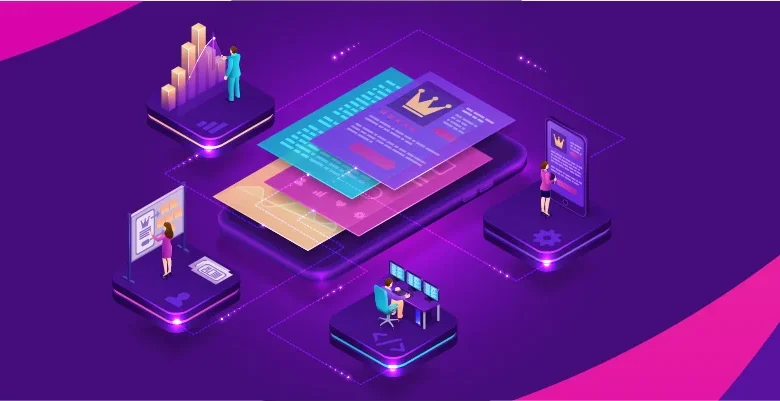The Ultimate Buyer’s Guide to IOS App Development Services

Planning to build an ios mobile application? Look no further because this ultimate buyer’s guide to ios app development services explores everything you’d want to know. From budgeting and team selection to getting-to-know the development phases and avoiding common mistakes, we’ve got it all covered so you can quickly hire a professional iOS app development service and get started!
Step 1. Define Your App’s Scope & Purpose
Before you partner with a service, it’s crucial that you define the why behind your app, you can do that quickly by jotting down answers to the following questions:
- What business need does the app solve?
- Who will use the app and how often?
- Which platforms should it support beyond IOS?
- Do you want the app to integrate with the existing systems at your business (like CRMs or ERPs, etc.)?
Answering these quick questions can really help build clarity around the scope, complexity and essential features of your app, which in turn, can save you from spiraling into expensive and unorganized development cycles.
Step 2. Decide Between Native, Hybrid, or Cross-Platform
While native ios app development using either Objective-C or Swift can ensure seamless integration and incredible performance of the app, you can always choose between native, hybrid and cross-platform development on the basis of your budget and long-term goals.
In case, budget is your concern – cross-platform frameworks such as React Native and Flutter are cost-effective options. However, native ios development remains ideal for a high-performance, secure, and easily accessible application.
Step 3. Budgeting the Smart Way
The cost of ios app development can significantly vary. It is important you understand the cost breakdown and carry-out smart budgeting to finally build a successful ios app. Here’s the average cost of different ios apps based on their level of complexity, etc.
- Simple utility apps may cost in between $10,000 and $20,000
- Medium-scale app (such as, bookings, ecommerce) can cost in between $25,000 and $60,000
- Enterprise-grade apps with real-time or AI integration, etc. can cost around $60,000 and more.
While these are just design and development cost averages, you must accumulate app store maintenance, performance monitoring, updates for newer ios versions, and user support expenses when planning out the budget.
Step 4. How to Vet a Development Team
The most crucial part of it all is to choose the right development partner. The best advice is to look beyond flashy portfolios – a development team that has relevant case studies to showcase where they have actually helped businesses achieve goals in terms of numbers and metrics. The key areas to focus upon include:
- Expertise with ios app development frameworks such as, SwiftUI, Core Data, and UIKit.
- In-depth knowledge and command over Apple’s Human Interface Guidelines.
- Ability to grow and scale with your business.
- Proven success in your industry.
When finalizing the team, whether you’re hiring an offshore team or partnering with a local mobile app development company in Houston – always ask for sample codes, design systems, and a detailed explanation of their QA process so that you do not have to play a guessing game post hiring.
Step 5. Understand the Development Cycle
To make sure your hired ios development support offers the right development assistance, you must understand how an ideal development cycle looks like? Here’s a brief description:
- Discovery Phase – this includes technical feasibility assessment, feature prioritization for MVP, and competitive benchmarking.
- UI/UX Design – how they plan to go ahead with wireframes and user flows, creating high fidelity designs customized for iPhone screen sizes, and usability testing with real users.
- Core Development – this includes the core development activities such as modular code architecture building, third-party API integration, and backend logic and offline functionality development if required.
- Quality Assurance – this is an unavoidable phase which involves manual testing of the built code across multiple ios devices, beta testing via Test Flight, and automated unit and integration testing.
- Deployment – it includes making sure the app complies with app store standards, it is rightly optimized for visibility, and handling the submissions/rejections, etc.
- Post-Launch Support – this is an integral phase which involves keeping track of the OS updates, crash analytics, and maintaining user feedback iteration.
Step 6. Prioritize Features Wisely
Launching the entire website at once can dilute core offering and slow-down development. Therefore, the ideal way is to launch in phases, prioritizing features as follows:
- Must be including, login, main service functionality, and notifications.
- Should-haves including, analytics, payment integration, and in-app chat.
- Could-haves including, AI, advanced customization, and AR.
Step 7. Ensure Compliance and Security
IOS mobile apps, specifically those built for handling payments, data, or user communication must fully comply with the regulatory standards of Apple, including:
- Apple Store Review Guidelines
- HIPPA and GDPR compliance on the basis of your region and industry
- Secure coding practices such as, token stage, SSL, and encryption.
In case you fail to attain full compliance, you may fail to launch the app or get it deleted from the app store.
Step 9. Prepare for App Store Submission
Apple app store has a well-defined and rigorous review process. If you want your ios app to successfully launch, it is important that you understand the process and align with that as well:
- Loading time is no more than two seconds
- It doesn’t crash or hang
- Offers an intuitive UI and relevant content that matches Apple’s guidelines.
Pro Tip: It is always a good idea to include a demo account for reviewers in case your app requires subscriptions or login.
Step 9. Plan for Growth and Maintenance
Launching an app is not the end. In fact, it is the beginning of a long term need for growth and maintenance. Your growth plan may include:
- Monitor analytics (usage, retention, churn)
- Introduce new features based on user feedback
- Roll out performance updates
- Manage ios version compatibility every year
Pro Tip: always partner with a mobile app development company that offers scalable support and not just one-time development assistance.
Common Mistakes to Avoid
- Do not skip documentation, without that you may face issues handling future updates.
- Do not overload your MVP, focus on a clear, single problem first.
- Make sure you do not overlook the ASO aspects, it can impact your app’s discoverability on the app store.
- Don’t forget to keep track of the user behavior and patterns as well as making updates and iterations accordingly.
Final Thoughts
Investing in iOS app development services is a long-term decision. The most successful apps are built on a foundation of clear business goals, a disciplined approach to feature rollout, and a development team that communicates transparently and iterates fast.
Whether you’re outsourcing to a boutique team or working with a top-tier mobile app development company, make sure your chosen partner aligns with your vision, timeline, and growth strategy.
With the right guide and a strategic mindset, your iOS app can evolve into a valuable asset that boosts engagement, builds brand loyalty, and generates serious ROI.




